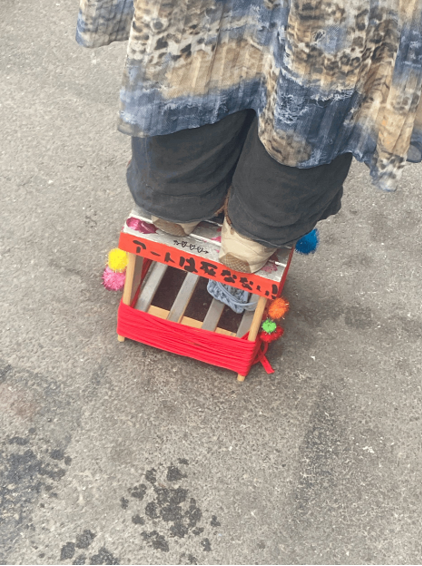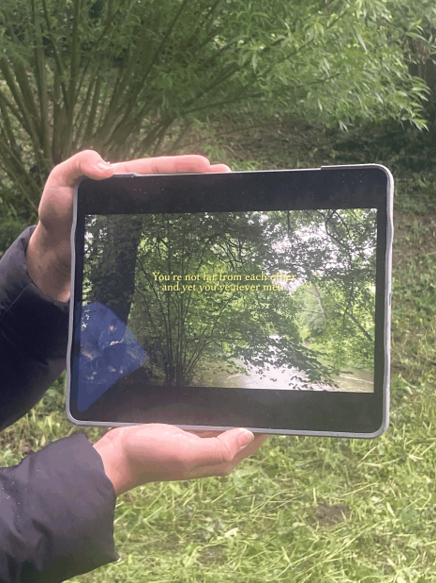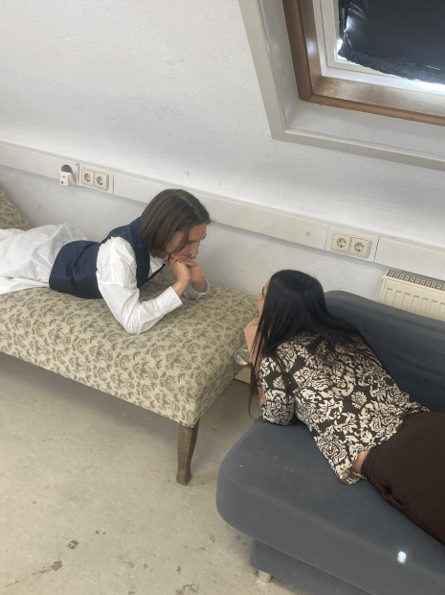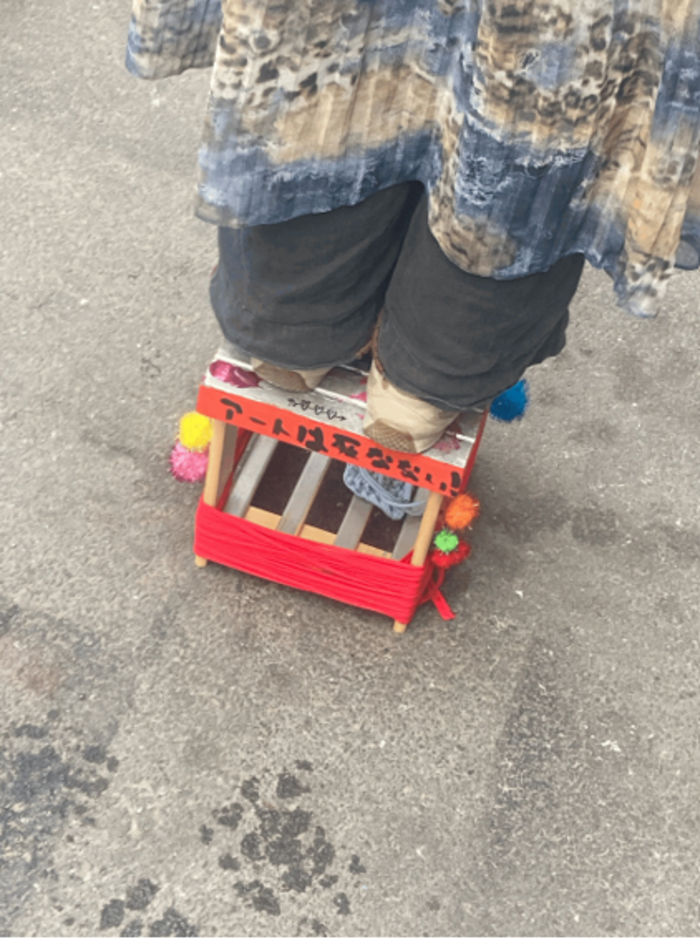ARTIST AND AUDIENCE: A story of love and fear
ARTIST AND AUDIENCE: A story of love and fear was a Bauhaus.Module during the summer semester 2024, exploring different attempts of creating art-in-relation to others. Art-in-relation arises from, with and for relationships between artists and audiences. It establishes dynamic roles between creating and receiving subjects and can also appear under the terms of relational art, socially engaged practice, dialogic art or participatory art. The following text describes aspects of the common process in the module, using a short story written by a student as narrative framework.
There once was an artist, simply known as „the Artist“. For years, the Artist was rarely seen on the streets. It was said, that they would be working all day on their artistic projects. Even at night one could often see the lights glowing in their atelier until the sun began to rise again.
About Artists
The class assembled a group of people with diverse relationships towards their artistic practices. Some might program data for a day and work on a novel project during their freetimes, some spend lots of time painting in their atelier aiming to build up a professional artist career, some people being surrounded by art school dialogues all day while some others long for the possibilities of creative exchange. The course encouraged the students to produce artistic works in weekly practical tasks within a set time frame, which were viewed and discussed in the group afterwards. The prompts set focus on art for & with others. The definition of the artist subject as an isolated genius shifted towards the artist as the beginning point of a relationship in progress.
| Choose a non-human spectator you want to create something for. It can be an animal, an object, a virtual character. Observe them, get to know them, do some research on them. Set yourself a timer of 50 minutes and make a small artwork for your non-human spectator. |
Furthermore, the class initiated a performative vernissage in which the participants showed works to each other that were never shown before because of insecurities, fears or bad luck. Playful acts like this opened a space to talk about art as work and struggle, provided support for those who had little practice in self-confident artistic work in an academic setting before and relaxation for those whose practice at art university was associated with a lot of pressure, high self-demands and uncertainty. "The artist“ was not primarily characterised by the quality of their final result, but by the quality of their creative process as a courageous, self-reflective and sensitive movement into the open. In one of the last weeks the group designed „the artists pedestal“, a decorated stool that served literally as a stepladder to enable your self-understanding as „artist“, where everyone could step on voluntarily.

One summer morning a new face entered the village. A new neighbour that was for some strange reason named „Audience“ by their parents. In the supermarket the Artist saw Audience for the first time, said Hello and then quickly left the store, forgetting to pick up their carrots and rice. Audience was baffled by this strange meeting but as they figured out by the excited gossiping of the villagers, the house they moved in was directly opposite from the Artists. So they decided to bring the Artist their forgotten carrots and rice.
About Audiences
Instead of talking about audience as the strange unknown, the seminar addressed the students as the first recipients of their own and one another’s work. Therefore, each participant had to unearth qualities that were sometimes buried due to the production logics of the present: Abilities to listen and take in, to be present and witness without immediate judgment, to make space for associations, emotional responses or precise observations that were not primarily related to their perspectives as professionals.
For each produced piece the class explored the ideal conditions of its presentation according to own needs and wishes as spectators: A poem about connections became a dialogue that was read aloud by the author and its recipients; a digital graphic showing political statements had to be presented by a volunteer holding the laptop above their head, becoming a human demonstration sign; a painting on the floor made the recipients bow towards it; a sketch showing an unfinished landscape was exhibited on the windowsills, visually embedded in the landscape you could see through the window. These explorations created an awareness of how the effect of a work is always related to its context and the physical and emotional state of its spectators. The recipient emerged as an important counterpart to the artist, whose knowledge and perspective could not only influence the artists idea, but also play an important role in the making of the artwork itself.

When Audience knocked at the door nothing happened for quite some time. Then the door opened very slowly and just a small bit. The Artists nose peeked through. - Who is it? they asked.
- Hey it’s me, Audience, your new neighbour.
- What do you want? If you come for art: I think nothing I produce is worth to share anymore.
Audience smirked.
- I just wanted to get you your rice and carrots.
- Oh. Thank you. So I guess my first answer was oversharing in a way.
- Its okay. Actually I like it if people share about their insecurities. I feel better about my own imperfections now.
About Relations
According to the different tasks, the participants created art that only became visible in dialogue with its recipient, art that celebrated the recipients hidden stories or skills, art that used its resources to do favours. Within a practice where the group had to create art for each other in teams, one student repaired the broken hat of her partner, using her resources and skills to repair something that her fellow student wouldn’t have done for herself. On the inside, she added a secret embroidery that referred to their currently noticed shared love for dogs. Another student wrote a fictional New York Times book review in which she passionately described the successful publication of a poetry anthology by her fellow student, putting something into performative reality which was yet a secret dream of her poetry-writing partner. Asked about her process for the book review, she said she was first thinking about writing a poem responding to the poems of her commission-partner but decided for the review to spend more time on the adequate description of her partners aesthetics instead of investing in her own sophisticated lyrical expressions. Anyway, the students reflected their own interests and wishes on doing something as well, noticing that „doing something for someone else can be inherently selfish“ (student’s quote), that the artist might depend on the audience more than the audience depends on the artist.
In preparation for the reality outside and after the seminar, where art was created for and with each other in a safe space, the students practiced various invitation strategies for different recipients. In a self-made exhibition of event flyers, the personal and approachable addressing of potential audiences, attractive deals such as free snacks and drinks and the precise communication of the event’s content through accessible language and aesthetics were identified as essential criteria for good invitations. Trying to win even non-human audience groups, the group researched potential presentation venues and invitation strategies to attract urban pigeons for the screening of a video work, produced for and about them. Sometimes this confronted the group with failure, with the realisation that just because you do something in public its not necessarily interesting for „the public“ and that in many cases you really have to work for the attention of your audience.
Overall, the simultaneity of the taken roles as artist and audience made it possible to become aware of the subjectivities in perception: Something being a small gesture for one person can mean a lot to another. It is valuable to give your own work the opportunity to enter into a relationship with others. And it is always important and worth it to invest in a good relationship between artist and audience.

- I like you, Audience smiled.
- I like you too. the Artist said.
And thus a story of fear ended and a story of love began.
As it is a relationship-in-progress, it is important to never know the end of the common story of Artist and Audience. To stay questioning, to stay insecure. During the last class of the semester, the group celebrated a small ending ritual and used a handsaw to destabilize „the artists pedestal“, to metaphorically interrupt the artists confidence towards their audiences, to make sure that you can never be completely sure about your relationship. Each participant cut out a small piece of the wooden stool, a tiny bit of the pedestal for take-away.
ARTIST AND AUDIENCE: A story of love and fear.
The Bauhaus.Modul was held by Nadja Sühnel, Std. Master Of Arts, Media Art. In her own practice she invests in interpersonal and more-than-human relationships, making radio plays for her friends, videos about her grannies, little songs for the birds on her windowsill, a commissioned dance for an audience member. Coming from a background in theatre, she always tries to invite her audience into a neighbourly atmosphere where feelings can be felt and shared realization of our existence has space. With her Bauhaus module, she tried to lovingly lower the bridge of the fortress that is art university, to playfully undermine some projections onto "bubbles outside the university" or "the public" and replace them with real experiences and relationships.
This text was created as part of the presentation of the Bauhaus.Module of the summer semester 2024.
Written by: Nadja Sühnel (Std. Master Of Arts, Media Art)
Titel: ARTIST AND AUDIENCE : A story of love and fear.
Teaching person: Nadja Sühnel (Std. Master Of Arts, Media Art)
Mentoring: Prof. Ana Prvački (KG)
Participants: Ava Berkson, Niklas Dunschen, Anja Hanschmann, So Jeong Hyun, Tadashi Kimura, Marleen Kölmel, Zoë Lipp, Ghazal Randhawa, Kayla Rizzo, Livia Schümann
Artist & Audience Story: Niklas Dunschen
Semester: Summer 2024

